|
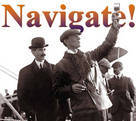
 Up
Up 
 Pilots,
Pilots,
Planes
and Pioneers

(You are here.)
 Down
Down




  Need
to Need
to
find your
bearings?
Try
these
navigation aids:
If
this is your first
visit, please stop by:
Something
to share?
Please:



|
|
Available in Française, Español, Português, Deutsch, Россию,
中文,
日本, and others.
 hile
the Wright brothers may have been the first to make a sustained,
controlled flight, they were just two among hundreds of brave men
and women who helped to give the world its wings during the earliest
days of aviation. Their Flyer was but one of many historically
important aircraft. Below are brief descriptions and photos of some
of the most important people and planes, and where available
resources and links where you can find more information. In some
cases, contributors have supplied expanded
histories and biographies. Those are listed at the right and linked below. hile
the Wright brothers may have been the first to make a sustained,
controlled flight, they were just two among hundreds of brave men
and women who helped to give the world its wings during the earliest
days of aviation. Their Flyer was but one of many historically
important aircraft. Below are brief descriptions and photos of some
of the most important people and planes, and where available
resources and links where you can find more information. In some
cases, contributors have supplied expanded
histories and biographies. Those are listed at the right and linked below.
A
 B
B
 C
C
 D
D
 E
E
 F
F
 G
G
 H
H
 I
I
 J
J
 K
K
 L
L
 M
M
N
 O
O
 P
P
 Q
Q
 R
R
 S
S
 T
T
 U
U
 V
V
 W
W
 X
X
 Y
Y
 Z
Z
|
|
 |
|
|
Feng Ru was an
inventor, aircraft designer, aviator, and visionary who is
remembered as the "father of aviation" in China. He came to
California as a young boy in 1895, hoping to escape the political
and economic turmoil that had crippled nineteenth-century China. He
found things little better in America where prejudice against the
Chinese and institutionalized racism severely limited the schools he
could attend and the jobs he could hold. Nonetheless, he taught
himself mechanical and electrical engineering. By the time he was in
his twenties, he had a reputation as a skilled machinist and an
inventor. He heard about the success of the Wright brothers
shortly after they first flew and immediately understood the
military potential of the airplane. He began his work in aviation in
1906 and completed his first airplane in
1907. It was unsuccessful, but his second airplane flew for twenty
minutes on September 22, 1909 just outside of Oakland, California.
It was also the first powered flight on the West Coast of America.
With the backing of several Chinese-American businessmen, he started
his own airplane manufacturing company, the Guangdong Air Vehicle
Company.
He continued to make test flights and built a third aircraft
based on the designs of Glenn Curtiss. His success caught the
attention of the Chinese revolutionary Sun Yixian (known as Sun Yat-sen
in the west), who asked him
to bring his airplanes to China to aid in the rebellion against the
Manchu Qing monarchy. Feng returned to Hong Kong, China on March 21,
1911 and was given the rank of Captain in Sun's army. Although little
is known about his role in the war, it is more than likely
that he was the first aviator ever to fly a military mission.
After the revolution succeeded in late 1911, Sun Yixian made him
head of the newborn Chinese air force. Feng built another aircraft
– the first to be manufactured
in China – but died during a
demonstration flight on August 26, 1912. Sun commanded that he be
buried in a shrine with soldiers who served in the revolution and
that the words "Pioneer of Chinese Aviation" be inscribed on
his tomb.
|
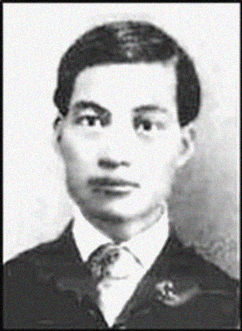
Feng Ru, known in San Francisco, California as Fung Joe Guey.
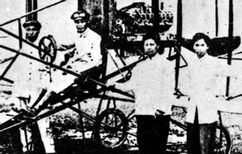
Feng Ru in the cockpit of the Feng
2 in Guangdong, China in 1911.
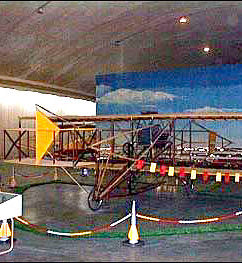
A replica of Feng's 1912 aircraft, the first built in China, in the
China Aviation Museum in Xiaotangshan, China, 40 miles (64
kilometers) north of Beijing.
|
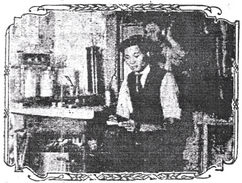
Feng Ru in his tiny workshop in Oakland, California in 1909.
This was the sole facility of the Guangdong Air Vehicle Company.
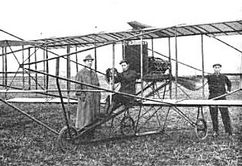
Feng Ru's second successful aircraft, the
Feng 2, in 1910. The engine was built by E. J. Hall, the
co-designer of the legendary
Liberty airplane engine. The
Feng 2 engine was among his first designs.
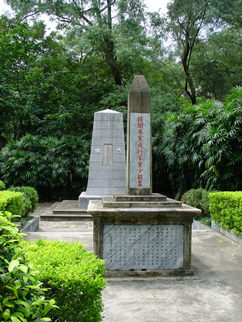
Feng Ru's tombstone at the Mausoleum of the 72 Huanghuagang Martyrs
in Guangzhou, China. The mausoleum commemorates revolutionaries who
overthrew the Chinese monarchy in 1911.
|
 |
Ferdinand Ferber
was a French artillery captain who, in the years after Lilienthal's
death, single-handedly kept the notion of heavier-than-air flight
alive in France. He wrote exhaustively on aviation
and attracted the attention of Ernest Archdeacon, another French aviation
enthusiast, who had organized the Aero Club of France in 1898. In 1901, he read a magazine article about the research of
Octave Chanute. He began corresponding with Chanute and learned of the
Wright brothers, then began corresponding with the brothers themselves and
made a crude copy of their 1901 glider. After some modification, he tested
a motorized version of the glider on a crane in 1903 but was
dissatisfied with the performance. Also in 1903, Ferber and
Archdeacon invited Chanute to speak at the club and his news of the
Wrights galvanized the members and spurred them to pursue their own
aviation research. Ferber built a trend-setting tail-behind glider in
1904. He finally achieved a flyable aircraft of his own design in
1908, but decided to purchase a Voison for exhibition flying in
1909. He was killed in this airplane on 22 September 1909 just prior
to an attempt to fly the English Channel.
|
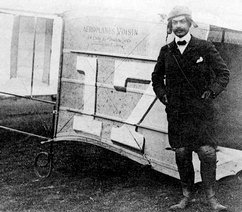
Captain Ferber in his flying togs, standing beside his Voison in
1909.
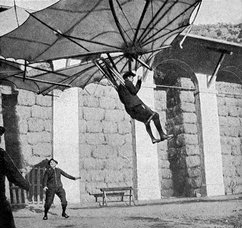
Ferber gliding in 1901, hanging from one of his earliest designs.
|
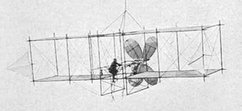
Ferber tests a motorized version of his
Type du Wright airplane as
it hangs from a crane. It never achieved free flight.
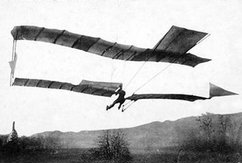
Ferber's influential 1904 glider had an elevator in front and a
horizontal stabilizer behind.
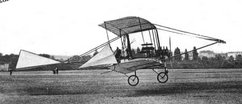
The 1908 Ferber No. 9.
|
 |
Abbas Qasim Ibn Firnas was a scientist,
inventor, and musician who lived in Andalusia, as the region around
Cordoba, Spain was known when it was under Muslim rule and part of
the vast Ottoman Empire. Among his many accomplishments were the
manufacture of glass from sand, a method for cutting facets in
crystal, and the first metronome to keep time in music. In 852 CE,
Firnas witnessed an attempt to fly
from a minaret of the Great Mosque in Cordoba. The would-be
aviator survived the fall – the
huge cloak he used for wings acted as a parachute. Firnas was
intrigued and spent the next two decades studying birds, bats, and
wind-borne seeds to discover the secrets of flight. (Some historical
accounts say the Firnas was the jumper and he spent years in
study to discover what he did wrong.) In 875 CE he was ready to make
his own attempt (or a second attempt). Hanging from a tail-less
glider, he jumped from a high point in the city and made a short,
uncontrolled glide. He injured his back when landing, putting an end
to his test flights. Nonetheless, he was the first scientist ever to
study and test the possibility of manned flight using a fixed-wing
aircraft. There is a crater on the dark side of the Moon named in
his honor.
|
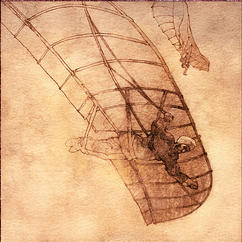
An artist's conception of the flight of Abbas ibn Firnas.
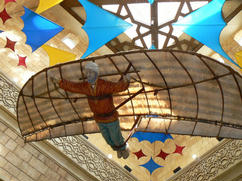
This conception of ibn Firnas' glider hangs in an Arabian museum.
It's not a replica; no plans for the historic aircraft survive.
|
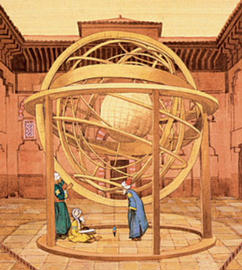
Among ibn Firnas' many inventions was one of the first planetariums.
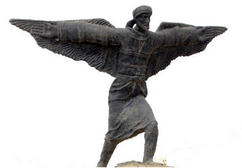
This statue of ibn Firnas stands in Baghdad, Irag at an airport
named for him.
|
|
 |
|
Charley Furnas
of West Milton, OH was the second mechanic hired by the Wright brothers
(after Charley Taylor) to help them build airplanes. They needed an extra
hand in early 1908 getting ready to demonstrate airplanes in France
and for the U.S. Army. Charley also assisted the Wrights in Kitty
Hawk with the initial test flights of their two-seat airplane and became the world's first airplane passenger, flying with
both Wright brothers on 14 May 1908.
(The only other person who would fly with both Wilbur and Orville
was their sister Katharine.) Charley also helped Orville at the Army
trials in 1908. He died of tuberculosis in 1941. For an expanded biography of Charley
Furnas, see
The First Airplane Passenger.
|
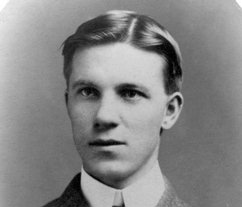
Charles Furnas.
|

The Wright Flyer III in Kitty Hawk in 1908, configured to carry two
people.
|
 |
|
|
|

